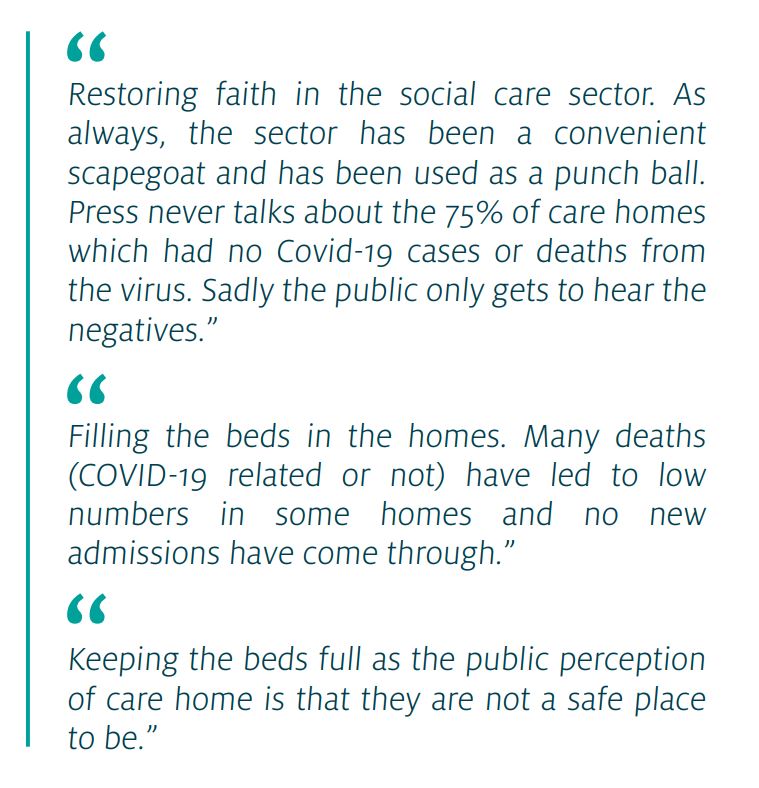Published Wednesday 12th August 2020
In the UK there are circa 400,000 elderly people whose home is a residential care home. It is true that a large majority of these will be challenged by infirmity and co-morbidity.
Most residents have reduced cognition, complex health conditions and physical frailty, many will be in their last year of life. Importantly this is a population of more than three times that of the acute hospital population. Covid-19 is particularly threatening to the elderly in care homes. Not only because of their individual frailty but also because of the physical environment of a care home and the close proximity they share with their fellow residents.
Some outbreaks in care homes have sadly resulted in many more deaths than normal. However, I am pleased to report there are also several of my care home owner contacts who have reported a relatively light impact from the virus on residents. There has been significant geographical variation reported. Clearly evidence shows care home residents have a particularly low defence to Covid-19 if they develop severe shortness of breath (hypoxia).

There have been so many reports in the media, often conflicting and subject to much comment and criticism from care home senior managers and owners because of the focus on extreme examples. This is not the subject of this article but understanding the picture from the care homes themselves is. Which is the reason Expense Reduction Analysts Healthcare Team decided to conduct a Europe wide survey to understand the picture from the homes themselves. We will be reporting the full survey results shortly, but here are some highlights from the UK results.
I know that email inboxes have become swollen with webinars, online engagements and surveys in recent weeks and so I am especially grateful to the many responses we had from owners, senior managers and home managers from a wide range of homes, groups and local authorities.
The reason for the survey was to understand the real picture of the effects of Covid-19 on the elderly care home sector. From the factual answers to the survey we can then make sure our response to care homes is based on the latest information they have provided. We can then bring help in the areas that we are being told need it the most.
The main issues which provoke most concern in order are:
- Admission of new residents.
- Physical reorganisation of the site.
- Availability of Covid-19 Tests.
- Supply of medication
- Availability of masks and other PPE
- Increased costs of supplies
- Cash flow issues
- Catering and food supplies
The biggest concern looking to the period post crisis was clearly restoration of occupancy levels.

Input prices are a real concern. The main areas highlighted are:
- PPE
- Janitorial Products
- Pharmaceuticals
- Staff & Recruitment costs
- Food
- Insurances
- Maintenance costs
In truth there is a consensus that there probably will be help. Mainly with finances and regulatory compliance to changing regulations. To summarise, as the first peak of infections passes there is a massive assessment of risk management for the future being undertaken.
New demands have arisen as it will be some time before “normal” family visits can resume. How will the needs for family communication with loved ones be addressed? There is a large technology gap to be addressed. Recruitment and temporary staffing have been a big challenge. There are increased numbers of applicants for care roles which is encouraging but resourcing the selection process is a challenge as home resources continue to be stretched.
Sourcing temporary staff became an auction in some areas with prices spiralling upwards and out of control. Strengthening supply chains and choosing the right supply partners to mitigate future stresses is critically important.
Input costs have risen dramatically and need expertise, resource and insight to manage them back down to realistic market levels. All these issues are urgent and need addressing with the vision of expertise. When the crisis arose, many organisations were caught on the back foot and will be planning to stand firmly on two feet if and when the next wave comes in.
The Healthcare team at Expense Reduction Analysts are perfectly placed to help you find the best solutions to these issues. And finally, to set a new precedent, I set out to write this article without the use of the word unprecedented.

About the Author: Duncan Levey, has extensive knowledge of manufacturing and healthcare sector businesses. Having managed market-leading companies to record levels of success he is now bringing the same results to his ERA clients.